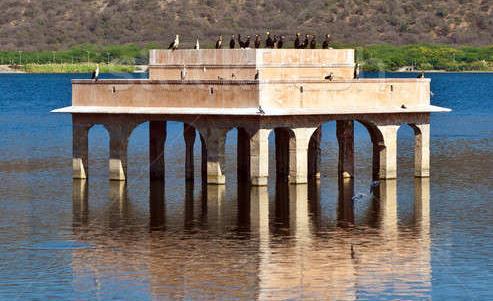
9 minute read
4. CASE STUDY 4.1 Kankariya Lakefront Development, Ahmedabad 4.2 Gopi Talav, Surat 4.3 Mansagar Lake Jaipur 4.4 Lake Pichola, Udaipur
4.1 KANKARIYA LAKEFRONT DEVELOPMENT, AHMEDABAD
4.1.1 Project Information
Advertisement
Location- maninagar, ahmedabad, gujarat Project type – lakefront redevelopment Client – ahmedabad muncipal corporation Consultant- HCPDPM Project year – 2006-2008 Stakeholders- tourists, nearby locals, kids and parents, eating enthusiasts, joggers, hawkers, service providers
SITE LOCATION
LAKE OVERALL VIEW
4.1.2 History

The construction of the lake started by sultan muizz-ud-din muhammad shah II in the 15th century. The inscription at the lake mentions that it was completed during the reign of sultan qutb-ud-din ahmad shah II in 1451. According to this inscription, its name is placed as "hauj-e-qutb" (pond of qutb) after him.
The kankaria lake has been an inseparable part of the identity of ahmedabad since its foundation in 1451. Kankaria tank was included in municipal limit in 1884 A.D.
In 1928, Kankaria Preservation Act. was declared protected under the Ancient Monuments
4.1.3 Purpose Of Development
However, the heavy traffic on the lake side road, disorganized informal activities, haphazard use of the right of way and the lack of sufficient access to the lakefront prevented the complete utilization of all its potentials.
Initiated by the ahmedabad municipal corporation, this project is a comprehensive lakefront precinct set in the heart of the city of ahmedabad, and conceived as a memorable recreational urban space. Its primary objective is to create an efficient and durable infrastructure which would foster entirely new activities in addition to supporting current ones.
4.1.4 Activities
Boating, Museum, Aquarium, Water walk, Butterfly park, Exhibition, safari, Ballon safari, Food courts, Kids play zone, Zoo park, Toy train Desert
4.1.5 Attraction At Kankariya Lake-
Zoo park, balvatika, amusement park, kids city, toy train, ballon safari, nagina wadi, stone mural park, aquarium, ambubhai purani vyamshala
4.1.6 Festivals And Other Events At Kankaria Lake –
September – ras garbha December – kankaria carnival January – dog show by ahmedabad police

ZONING

SECTION WITH PEDESTRIAN WAY

4.1.7 Cultures That Existed At Kankariya And Are Enhanced/Controlled By The Lake Front Development Project –
(i) Culture of celebration
Noting down events that take place at kankaria like dushhehra & eid celebrations etc.. Now events like kankaria carnival, navratri and other such events make kankariya as one of the most important cultural centers of the city.
(ii) Culture of food
Food is generally inherent part of indian culture. A public place like kankariya is no different when it comes to food. It would have started as a need, but definitely developed as a culture that is practiced by many, i.E. Enjoying food at the lake.
4.1.8 Cultures That Are Newly Added To Kankariya Lakefront Project –
(i) Culture of walkability (pedestrian friendly public space)
A complete pedestrian friendly space is difficult to achieve and implement in the current urbanized context of indian cities. This project made a successful attempt towards a complete pedestrian friendly public space.
(ii) Culture of public art
From wall paintings to stone murals, art has become an inherent culture of this place. Various events that promote this culture also are the living examples of the same.
(iii) Culture of recreation and games
Various games for kids like bungee jumping, water riders train ride etc. Has brought in the culture of involving kids in outdoor activities, also allowing kids to interact with various murals showing Gujarat's development in a public place like this.
4.1.9 Context And Opportunity
(i) Socio-economic context
The Kankariya lakefront is also the site of the annual Kankariya carnival that has been a major success for the last 4 years. The carnival has become one of the most awaited events in ahmedabad and every year there are a wide range of cultural programmes, performances, skits and competitions for people cutting across age groups. In addition to the social gatherings, this place acts as source of daily bread for many, who associate themselves with various activities like vending, hawking, etc. And benefit from those visiting the lake precinct at a daily basis, for various recreational activities related to food, lake, swimming pool, temple, zoo, garden, naginawadi, kids city etc.

(ii) Architectural / environmental context
Architecture is represented in terms of the public related buildings and open spaces like temple, garden etc. Dutch tombs, summer palace in nagina wadi and historical dadu dayal temple alongwith the sluice are living examples of medieval architecture at kankaria lake front. Naginawadi and zoo area along with the lake precinct form a garland of green area. A very distinct step was taken by the amc by starting census of planted trees.
TOY TRAIN NAGINA WADI
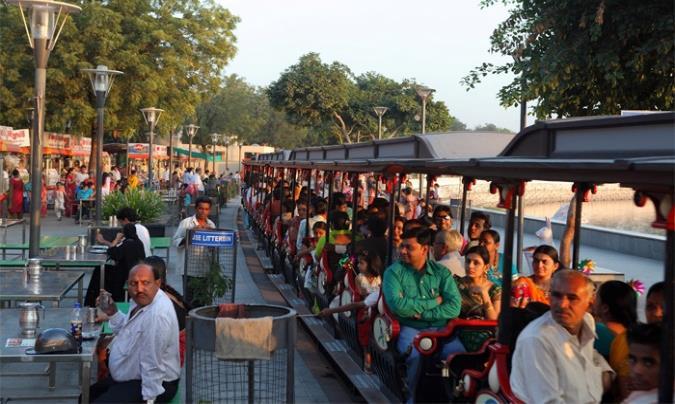

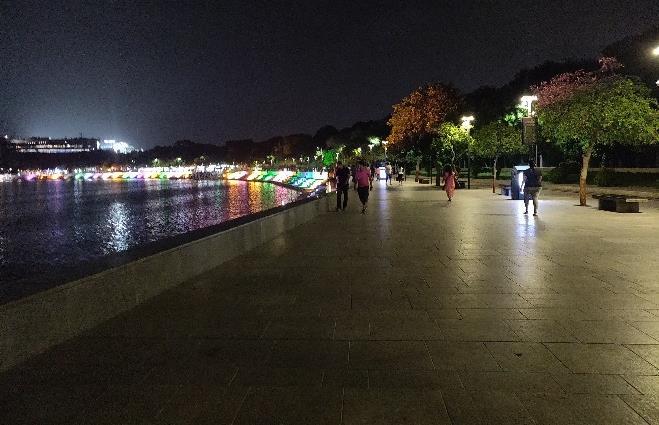
LAKE SURROUNDING AREA

4.2 GOPI TALAV, SURAT
4.2.1 Project Information
Location- Gopipura, Surat, Gujarat Project type – Lakefront redevelopment Client – Surat Municipal Corporation Designed by - Ar snehal shah, Ar vishal shah Project year – 2012 Stakeholders- tourists, nearby locals, eating enthusiasts, joggers, hawkers.
4.2.2 History
SITE LOCATION

Gopi Talav was built by Malik Gopi, who was an affluent merchant and governor of Surat during the Mughal empire. Gopi Talav (talab) is located in the walled city area of Surat in the inner ring (the older fort wall) and the outer ring (the extended fort wall) around the circular lake area measuring about 1,00,000 sq.Mt. That includes water body 35,300 sq.Mt and surrounding area 64,700 sq.Mt. The travel accounts of the 17th century describe Gopi Talav as “an important urban recreational space with religious significance. ” Around 500 years ago Gopi Talav was a part of the traditional water management system and was linked to the moats of the city wall. However, the talav started decaying due to rapid developments in the surrounding which hampered the natural catchments of the Talav..

4.2.3 Purpose Of Development
The Gopi Talav was lost its existence & identity so main concern was to give an identity to itself. In 2012, the Gopi Talav was renovated by Surat Municipal Corporation and the area surrounding it was redeveloped as a recreational facility.
4.2.4 Amenities
A water body of 3.30 ha. Water body Step well – conservation Theme parks Public plaza Jogging track Open –air theatre Viewing deck – jetty, food court Water sport facility – boating Central feature – aeration fountain and utility block for the
4.2.5 Zoning Of Lake Development
There are 7 thematic zones which depicting peculiarities of surat
History zones - this zone consists of history platforms, motifs, small amphitheatre, administration building and vav.
Food zone - the park premises include a food zone called “surat nu jaman zone” comprising of 17 units 1 toilet block and seating plaza with concrete benches.
Communal harmony zone - the communal harmony consists of meditation platforms, seating areas, lawns for performing yogas, conducting laughing club and a semi covered gazebo.
Diamond zone - the diamond zone is essentially a park area with ‘kohinoor fountain’ as the central feature of the zone. The zone also consists of a semicovered gazebo and benches for seating.
Textile zone - this zone consists of children play area with play equipment's, rubber flooring, benches for seating and toilet block.
Future zone - area of future zone is approx. 9000 sq.Mt. Which can be used for any future decided activities.
Environment awareness zone - this zone consists of a amphitheatre with a seating capacity of approx. 400 predominantly meant for organizing performances. park area and a big people. The area is
SECTION THROUGH FOOD COURT

SECTION WITH VIEW POINT

HISTORY ZONE GARDEN WITH SEATING BENCH
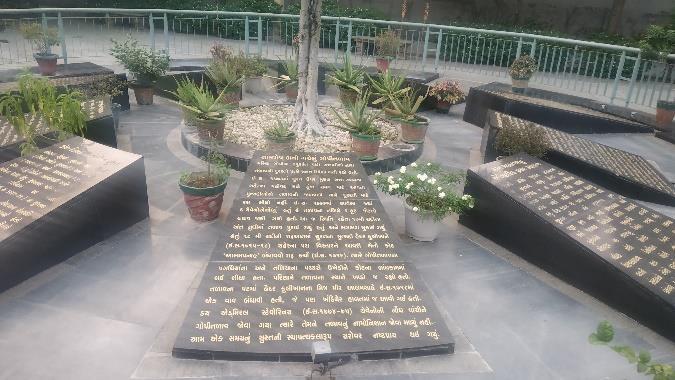


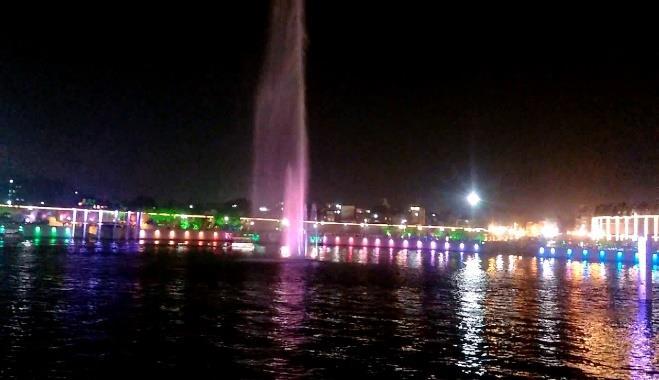
4.3 LAKE PICHOLA, UDAIPUR
4.3.1 Project Information
Location- Udaipur, Rajasthan Project Type – Lakefront Redevelopment Developed by – Rajasthan Government

4.3.2 History
SITE LOCATION
Pichola lake was built in 1362 AD by banjara, a gypsy "banjara" tribesman who transported grain, during the reign of maharana lakha. Later, maharana udai singh, impressed by the charm of this lake with the backdrop of green hills and also enlarged the lake by constructing a stone masonry dam in the badipol region on the shore of the lake.
4.3.3 Purpose Of Development
The main purpose of develop behind the lake pichola is to conserve the historic monuments like city palace, gangaur ghat, jag mandir etc.. To increase the number of tourists is also purpose of this.

4.3.4 Festival Which Are Celebrate On Lakefront
Gangaur festival Jal jhulni festival
4.3.5 Activities
Photography shoot Boating Festival celebration Walking around lake

4.3.6 Amenities
LAKE VIEW
Jag temple - A place where many destination weddings or movie shootings take place, Jag Mandir Palace is a large lake garden palace
Gangaur Ghat - A historical main ghat on the waterfront of Lake Pichola, Gangaur Ghat is one of the main attractions of visiting Lake Pichola. It is the main site for the Gangaur Festival and Jal Jhulni Festival.
Arsi vilas - Arsi Vilas is a small palace and an island where the royalty of Udaipur used to watch sunsets and is now a small bird sanctuary.
Sunset view point
Lakeside cafe and restraunts


4.4 MAN SAGAR LAKE, JAIPUR
4.4.1 Project Information
Location- Jaipur, Rajasthan Project type – lakefront redevelopment Developed by – Rajasthan government

SITE LOCATION
4.4.2 History
Man sagar lake is an artificial lake, situated in Jaipur, the capital of the state of rajasthan in india. It is named after raja Man Singh, the then ruler of Amer, who constructed it in c. 1610 The Jal Mahal is situated in the middle of the lake.
4.4.3 Purpose Of Development
The purpose of develop behind the Mansagar lake is to restore the historic monument Jal Mahal and rejuvenate the lake with also aim to develop for as a tourist destination.


LAKE EDGE BOUNDARY
AFTER RESTORATION BEFORE RESTORATION
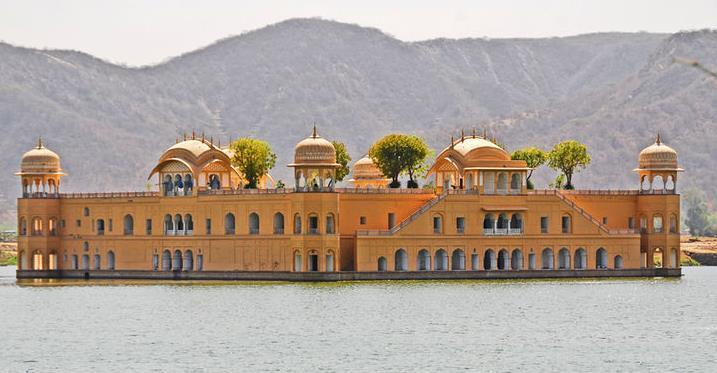

4.4.4 Migratory Birds
Throughout the year, more than 180 species of birds are making lake as a great attraction to bird watchers and tourists.
COMMON MOORHEN

WHITE PELICAN LIGHTMATTER FLAMINGO
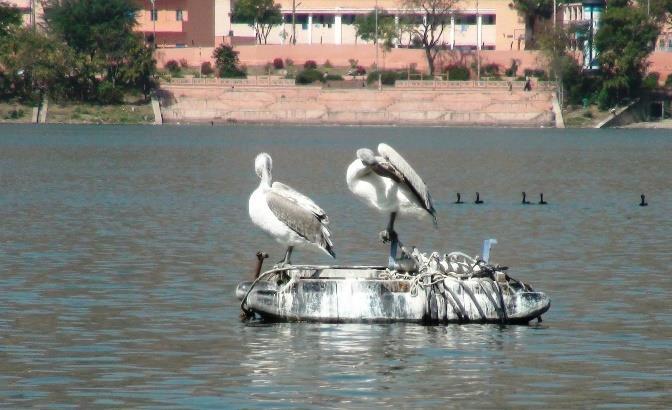

CENTER POINT OF LAKE
